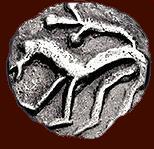








Designed by Nigel G Wilcox






The Paragon Of Metal Detecting
& Archaeology
& Archaeology
Powered By Sispro1
Anglo-Saxon & Viking A.D. - Currency Numismatics,
Sceat
For Reference ONLY
Everything For The Detectorist
Sceat

Aethelbald of Mercia (716-57)
Sceattas rarely carry legends of any kind, though a small number do name the mint of London and others carry short runic legends such as 'Aethiliraed' and 'Efe', which probably refer to moneyers rather than kings. One series, U, has been linked to King Aethelbald of Mercia (716-57) on the basis of its iconography, though this attribution is tenuous and recent research suggests it is very unlikely. It has also been suggested on the basis of the iconography of certain sceattas that they were issued by ecclesiastical authorities, such as bishops or abbots. Minting may not have been a strictly urban or secular prerogative, and coins were used for many payments and purposes beyond pure commercial buying and selling.
O +ALDFRIDVS around central annulet.
R: Left-facing quadruped
Silver sceat of Aldfrith of Northumbria, 685-704
Æthelbald (also spelled Ethelbald, or Aethelbald) (died 757) was the King of Mercia, in what is now the English Midlands from 716 until he was killed in 757. Æthelbald was the son of Alweo and thus a grandson of Eowa who was the brother of Penda, Æthelbald came to the throne after the death of his cousin, King Ceolred who had driven him into exile, During his long reign, Mercia became the dominant kingdom of the Anglo-Saxons, and recovered the position of pre-eminence it had enjoyed during the seventh century under the strong Mercian kings Penda and Wulfhere.
When Æthelbald came to the throne both Wessex and Kent were ruled by stronger kings, but within fifteen years the contemporary chronicler Bede describes Æthelbald as ruling all England south of the river Humber. The Anglo-Saxon Chronicle does not list Æthelbald as a bretwalda, or "Ruler of Britain", though this may be due to the West Saxon origin of the Chronicle.
St Boniface wrote to Æthelbald in about 745, reproving him for various dissolute and irreligious acts. The subsequent 747 council of Clovesho, and a charter Æthelbald issued at Gumley in 749-which freed the church from some of its obligations-may have been responses to Boniface's letter. Æthelbald was killed in 757 by his bodyguards. He was succeeded briefly by Beornred, of whom little is known, but within a year Offa the grandson of Æthelbald's cousin Eanwulf had seized the throne possibly after a brief civil war, under Offa Mercia would enter its most prosperous and influential period.
O +ALDFRIDVS around central annulet.
R: Left-facing quadruped
Silver sceat of Aldfrith of Northumbria, 685-704
Æthelbald (also spelled Ethelbald, or Aethelbald) (died 757) was the King of Mercia, in what is now the English Midlands from 716 until he was killed in 757. Æthelbald was the son of Alweo and thus a grandson of Eowa who was the brother of Penda, Æthelbald came to the throne after the death of his cousin, King Ceolred who had driven him into exile, During his long reign, Mercia became the dominant kingdom of the Anglo-Saxons, and recovered the position of pre-eminence it had enjoyed during the seventh century under the strong Mercian kings Penda and Wulfhere.
When Æthelbald came to the throne both Wessex and Kent were ruled by stronger kings, but within fifteen years the contemporary chronicler Bede describes Æthelbald as ruling all England south of the river Humber. The Anglo-Saxon Chronicle does not list Æthelbald as a bretwalda, or "Ruler of Britain", though this may be due to the West Saxon origin of the Chronicle.
St Boniface wrote to Æthelbald in about 745, reproving him for various dissolute and irreligious acts. The subsequent 747 council of Clovesho, and a charter Æthelbald issued at Gumley in 749-which freed the church from some of its obligations-may have been responses to Boniface's letter. Æthelbald was killed in 757 by his bodyguards. He was succeeded briefly by Beornred, of whom little is known, but within a year Offa the grandson of Æthelbald's cousin Eanwulf had seized the throne possibly after a brief civil war, under Offa Mercia would enter its most prosperous and influential period.
Copyright All Rights Reserved by Nigel G Wilcox E-Mail: ngwilcox100@gmail.com
Viking Menu
Viking Timeline
Anglo-Saxon Timeline
Pages
Information Data
Main Coin Menu
Anglo-Saxon
Menu
Menu
Member NCMD
A.S. Menu
























